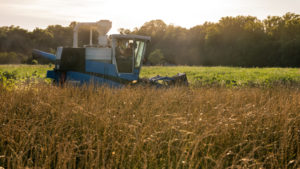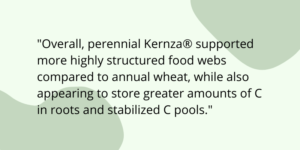Below the Surface: soil health and perenniality
August is a busy time for both The Land Institute and Kernza® growers. As interns shuffle from the fields to the threshing rooms, growers all around the country are at various phases of harvesting their Kernza® plots. Amidst the activity, we are revisiting research pertaining to perennial crops’ ecosystems services. In the paper summarized here, researchers focus on the relationship between perennial crops, nitrogen management, and lastly, soil food webs and carbon dynamics. The soil food web refers to a community of organisms that interact with one another and grow in the soil. These organisms decompose organic compounds and in certain cases consume smaller organisms, which play a crucial role in nutrient cycling and maintaining soil health. The concepts explored in the paper are central to the importance of perennial agriculture; they anchor our work, and that of our partners.

Sprunger et. al. observe at the outset that perennial grain crops’ extensive root systems and year-round ground cover may confer various ecosystem services, including reductions in nitrate leaching compared to annual row crops. However, they argue that more research is necessary to understand how perennial crops affect food web dynamics and soil carbon over time. To explore these relationships, the authors conducted a multi-year study in order to build on previous perennial crop research.
The researchers hypothesized that perenniality would be a more significant driver of soil food webs and soil carbon dynamics compared to nitrogen management, due to changes in newly added root carbon. Various studies have illustrated the need to apply nitrogen for perennial Kernza® to reach optimal yields. However, we also know that inorganic nitrogen fertilizer application negatively affects microbial communities. This paradox points at the importance of the authors’ study.
When growing perennial crops applied with inorganic nitrogen fertilizer, it’s important to broaden our understanding of the “net ecosystem benefits of perennial cropping systems” (Sprunger et al., 2019, p. 2). The genius of natural systems agriculture is the interconnectedness of ecological networks. However, this paper aims to disentangle the effects of perenniality and nitrogen management so that growers, researchers, and consumers can fully understand the ecosystem services provided by perennial cropping systems.

Researchers found that perennial Kernza® had greater carbon: nitrogen ratios in coarse roots, relative to annual wheat. This indicates that perennials likely have a significant capacity to store carbon in their deep roots, suggesting an ability for long-term soil carbon storage. Perennial Kernza® also supported more highly structured food webs compared to annual wheat. However, it is important to note that perennials need to be fully established before changes in microbial community structure are detectable.
There are a variety of systems and organisms that contribute to our understanding of “soil health.” This paper helps explain some of these systems–namely the relationship between perennial roots, carbon cycling, microbial composition, and nitrogen management.
Paper summary by: Sophia Skelly